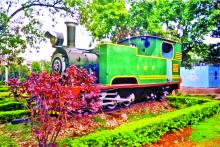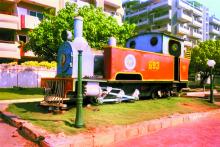Paralakhemedi Light Railway (PLR) was two feet six inches gauge railway. It was the brainchild of the erstwhile Raja of Paralakhemedi. The Kimedi country, consisting of Paralakhemedi, Paddakimedi and Chinna Kimedi, was under a single ruler till 1607. Paralakhemedi came under the British influence in 1768.
East Coast Railway came into existence in the year 1893 with the construction of the Cuttack-Khurda Road-Puri line covering a distance of 96 kms and its subsequent link up along the East Coast up to Vijayawada - junction point of Southern Maratha Railway and Nizam's Guaranteed State Railway. As a result, a total stretch of 1280 kms of East Coast Railway covering the entire coastal stretch of Cuttack - Khurda - Road - Puri - Palasa - Vizianagaram - Visakhapatnam - Kakinada - Rajahmundry-Vijayawada was opened for traffic between 1893 to 1896.East Coast Railway brought rail line to Naupada in 1894. The Raja of Paralakhemedi decided to connect his capital with Naupada which was only 40 kms away. With the government giving sanction in 1898, work began in full earnest. The line was opened to traffic in 1900. This railway line was built at a cost of Rs.7 lakhs.
There were three classes-Upper, Lower and Lowest. Most of the early coaches and wagons were supplied by Arthur Koppel Company of Calcutta, who assembled them from the kits supplied by Orenstein-Koppel of Germany. The initial livery was standard maroon. Sometime in eighties due to ingenuity of some staffer it was changed to the two-tone blue livery normally reserved for broad-gauge air-braked stock. PLR coaches had thus the unique distinction of being the only narrow gauge coaches to share livery with broad gauge stock.
Due to a change in the policy of the British Government, the Bengal Nagpur Railway, popularly known as the B.N.R, took over the northern section of East Coast Railway from Vizianagaram to Cuttack including the Branch Line of Puri by 23-01-1902. Accordingly the working of the PLR was taken over by the Bengal-Nagpur Railway in 1902. In the first few years, the PLR had incurred losses but after 1910, it started making marginal profits and after 1924-25, the profits increased. This motivated the Raja to extend the line to Gunupur in two phases in 1929 and 1931. There were now a total of ten stations between Naupada and Gunupur. Tekkali, Paddasan, Temburu, Ganguvada, Patapatnam, Paralakhemedi, Kashinagar, Lihuri, Bansidhara and Palasingi.
The management of BNR was taken over by the Government of India in October 1944. On 14-04-1952, at the time of the re-grouping of the Indian Railways it became part of the Eastern Railway. The merger of B.N.R. into Eastern Railway, however, did not last long and on 01-08-1955 it was merged with newly constituted South Eastern Railway. During the SER centenary celebrations in 1987, set of four postage stamps were released. One of the stamps featured the PL 691 locomotive.
The standard type of locomotive on PLR was the 20 ton 0-6-4 tank locomotive with small (27 inch diameter) coupled wheels and an axle load of only 4.75 tons. The Paralakhemedi engines were known as ‘PL’ class. The first locomotives to work on these lines were 0-6-4T, built by Brush Electrical Engineering Company, Loughborough. In 1928 three 0-6-4 T locos (All India no- 695,696, 697) were delivered by Kerr, Stuart and Co., Trent. One 0-6-4T loco (All India no-698) was delivered by Hunslet engineering Co. in 1931. Later with diesel taking over Mayurbhanj Light Railways, four 0-6-0 T (All India No-691,692,693,694) Kerr Stuart built locos were transferred to PLR. In 1987 four ‘ML’ and four ‘PL’ locomotives were homed at Naupada shed. Diesel took over from steam on 23rd April, 1992. The locos were ZDM5 (All India no-523,532) transferred from the Satpura lines. In early 2003 there were two services each in either direction. The first service from Naupada (1 NG) started at 0530 hrs reaching Gunupur at 0915 hrs. The first service from Gunupur (2 NG) started at 0930 hrs reaching Naupada at 1315 hrs. The second service from Naupada (3 NG) started at 1345 hrs reaching Gunupur at 1730hrs. The second service from Gunupur (4 NG) started at 1745 hrs reaching Naupada at 2130 hrs. In view of the continuous loss that this railway was making, railways decided to introduce rail bus in this section. The buses reached Naupada but were never used as by then government had decided for gauge conversion.
Bowing down to public demand, surveys were undertaken for broad gauge conversion in 1950 and again in 1964 and 1967.The foundation-stone was finally laid for the Naupada-Gunupur gauge conversion work at Naupada on 27th September, 2002. With effect from 1st April 2003 PLR became a part of the newly formed East Coast Railway. The line was finally closed for gauge conversion on 9th June, 2004.
Five of the locomotives from this railway have been preserved.
PL 691 has been plinthed outside Southern railway headquarters, Chennai.
PL 692 has been plinthed outside BNR hotel, Puri.
PL 693 has been plinthed on the Ramakrishna beach, Vishakhapatnam. It was plinthed there during Visakha Utsav in 1998.
PL 694 has been plinthed outside the Vishakhapatnam station
PL 697 has been plinthed outside DRM office, Vishakhapatnam. The locomotive has been plinthed as part of the centenary celebrations of BNR in 1988.






